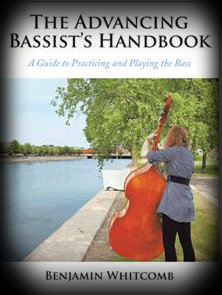Benjamin Whitcomb’s recent publication The Advancing Bassist’s Handbook is a refreshing new contribution to the canon of double bass technique materials. Dr. Whitcomb has written a similar volume for violin, viola, and cello, but he has tailored his book to the specific needs of bassists and has created a resource that fills a gap in the educational needs of developing students.
The Advancing Bassist’s Handbook is not so much a method book as it is a guide to mentally organizing oneself for practicing an instrument. “Willful progress” is a term that I found myself constantly thinking of as I read through the various sections of the book; it is not so much a method book as it is a guide on how to develop good practice routines and the mental capacity for critical self-analysis. Though the book is targeted toward bassists in the high school and early college years, there are valuable lessons to be gleaned regardless of age and stage of musical development.
The book is organized into four major sections:
- I. Introduction
- Why You Need This Book
- The Psychology of Practicing
- Organizing Your Practice Time
- II. The Content of Practicing
- Helpful Practice Tools
- Daily Warm-up Routine
- Practice Techniques and Exercises
- Improving Intonation
- Marking Your Music
- Practicing Without Your Instrument
- Sample Practice Session
- III. Advancing Your Musical Training
- Fingerings and Bowings
- Bowing Styles
- Musical Styles
- Playing Musically
- IV. Practical Applications
- Examples From the Literature
- Troubleshooting
- Postlude
- The Bass Repertoire
- The Science of Intonation
Like anyone who has spent a fair amount of their life’s hours in a practice room, I can immediately identify with the thought processes and structures outlined in this handbook. The book’s focus on structuring practice time will prove to be especially helpful to high school and college students.
The first section of the book deals with the psychology of practicing and how to “practice smarter” by reorienting practice room routines toward training your brain instead of your muscles. Everyone involved in musical performance at any level should read these first few chapters on concentration, motivation, and goal setting. They are filled with good life lessons for the practice room and beyond!
The second section of the book focuses on what should actually be happening in a practice session and on balancing more general technical work with repertoire-specific work. Practice techniques such as simplification, transposition, exercise creation, slow practice, add-a-note, and conceptual/theoretical practice are broken down. The clarity of description of each of these techniques to be quite refreshing, showing the reader in very specific terms how to practice. Developing a repertoire of practice tools for any given musical puzzle is one of the most crucial factors in student development, and it is refreshing to see it outlined in such an easily digestible and applicable manner.
The third section of The Advancing Bassist’s Handbook is all about getting better as a string player and as a musician. The first few chapters of this section discuss fingerings, bowings, and stylistic considerations from various musical periods. Perhaps my favorite chapter in the entire book is the one devoted to playing musically (Chapter 14). Finding a text that quantifies musical playing and offers specific practice methods for developing musicality is incredibly rare. The Art of Musicianship by Philip Farkas and Casals and the Art of Interpretation by David Blum are two canonical texts on this topic. This chapter from Dr. Whitcomb is certainly in the same league as the Farkas and Blum texts and is reason alone to seek out a copy of this book.
The fourth section of the book is the most instrument-specific, with examples of major works from the bass repertoire and advice on practicing specific passages from these works. Whitcomb covers The Elephant, Sonata in G Major by Marcello, Eccles Sonata, and the Capuzzi and Dragonetti Concertos. He also offers up a Q&A section on common issues in bass performances and possible solutions, such as advice for collapsing knuckles, intonation, shaking bow, vibrato, and memory slips. An appendix on bass repertoire (including a possible year-by-year recommendation of repertoire to study) and another appendix on the science of intonation round out the book.
The Advancing Bassist’s Handbook is available in print, as a Kindle book, or as an iBook. It is a wonderful addition to the knowledge base and would be of great benefit for any student serious about getting better as a musician.
Dr. Whitcomb has also written three other handbooks for the other members of the bowed string instrument family. All of them are similarly well-developed guides for practicing and musical development on these instruments.
The Advancing Violinist’s Handbook
The Advancing Violist’s Handbook
The Advancing Cellist’s Handbook
Bass News Right To Your Inbox!
Subscribe to get our weekly newsletter covering the double bass world.

